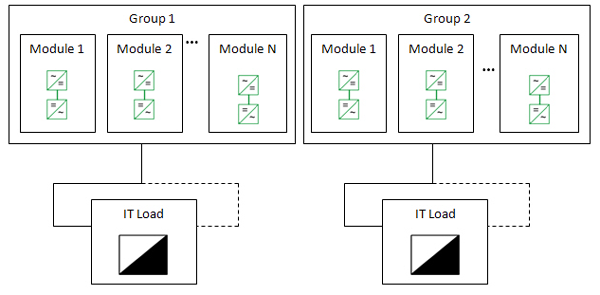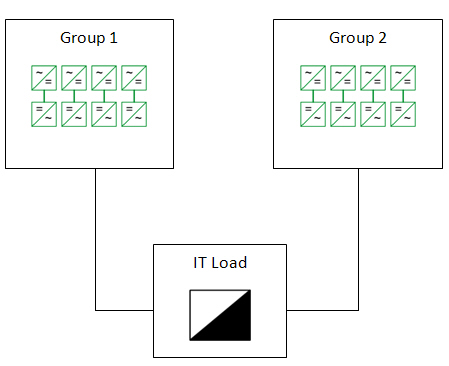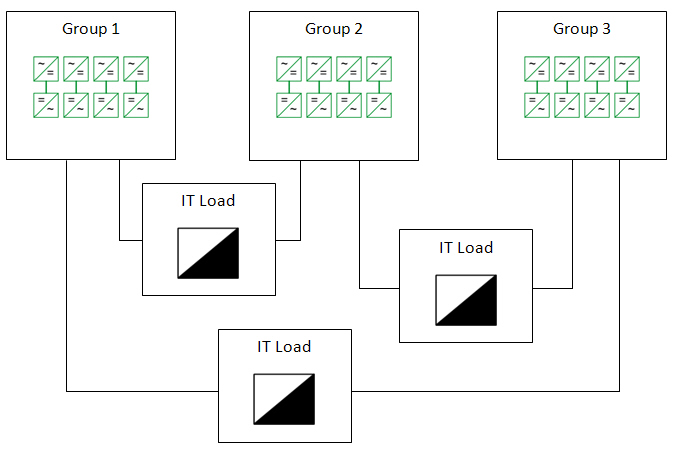UPS system redundancy types
You can create a UPS system to achieve power redundancy for IT equipment loads in different ways, depending on how the UPS units are grouped together and how they are connected to the equipment power supplies. This configuration tool supports several industry standard configurations.
The UPS system supports the following redundancy design types:
N Type
The N system configuration is for one or more UPS modules which work together to supply power to the IT load. There is no redundancy, except optionally to the second power supply of each piece of equipment.
Each UPS system with an N configuration can have multiple UPS groups, where each group is connected to a different load. The number of modules within each UPS group can be different. Within each group, all UPS modules must have the same derated nameplate rating value (kW).

N+1 Type
The N+1 system configuration is for one or more UPS modules that work together to supply power to the IT load. There is simple module redundancy in that one of the modules can be rendered inoperative or be taken off-line. The load is spread among all remaining UPS modules, but the peak load is such that if one module stops working, the others will be able to assume its load. Another way to look at it is, N UPS modules will be able to support the peak IT load. If the peak IT load is more than N can support, then system design redundancy will be lost.
There is the option to connect the system of modules to the second power supply of each piece of equipment, but both power supplies are connected to the group of UPS modules.
Each UPS system with an N+1 configuration can have multiple UPS groups, where each group is connected to a different load. The number of modules within each UPS group can be different. The modules within a UPS group must have the same derated nameplate rating value (kW).

N+2 Type
The N+2 system configuration is for a group of UPS modules that work together to supply power to the IT load. There is simple module redundancy in that any two of the modules can be rendered inoperative or be taken off-line. The load is spread among all remaining UPS modules, but the peak load is such that if two modules stop working, the others will be able to assume their load. Another way to look at it is, N UPS modules will be able to support the peak IT load. If the peak IT load is more than N can support, then system design redundancy will be lost. An example of an N+2 system is five UPS modules connected to the IT load, but the peak IT load never exceeds the capacity of three of the UPS modules.
There is the option to connect the system of modules to the second power supply of each piece of equipment, but both power supplies are connected to the group of UPS modules.
Each UPS system with an N+2 configuration can have multiple UPS groups, where each group is connected to a different load. The number of modules within each UPS group can be different. The modules within a UPS group must have the same derated nameplate rating value (kW).

2N Type
The 2N system configuration is for two or three groups of UPS modules that supply power to two different power supplies in each IT load. For redundancy, an entire UPS group can stop working or be taken off-line, and the IT equipment will still be supplied with power. It also means that either one of the two power supplies in an IT load can be rendered inoperative. The load is spread among all UPS modules, but the peak load is such that if an entire group’s worth of modules is not working, the remaining modules will be able to assume their load. Another way to look at it is, N UPS modules will be able to support the peak IT load. If the peak IT load is more than N can support, then system design redundancy will be lost.
Each UPS system with a 2N configuration can have two or three UPS groups. If there are two groups, both must be connected to the same load. If there are three groups, then there are three separate loads and each group is connected to two of the loads. The number of modules within each UPS group in a UPS system must be the same in a 2N configuration. Additionally, all UPS modules within a UPS group must have the same derated nameplate rating value (kW).
In the first example, there are two groups with four UPS modules each. In a 2N configuration, one group can stop working and the system will still have the designed redundancy. Therefore, the value for N is four. So, the total IT load cannot exceed the derated nameplate rating of four of the UPS modules.

In the second example, there are three groups with four UPS modules each. In a 2N configuration, one group’s worth of UPS modules can be rendered inoperative and the system will still have the designed redundancy. Therefore, the value for N is eight. So, the total IT load (for all three IT load groups shown below) cannot exceed the derated nameplate rating of eight of the UPS modules.

2(N+1) Type
The 2(N+1) system configuration is for two or three groups of UPS modules that supply power to two different power supplies in each IT load. The redundancy provided means that an entire group of UPS modules, plus one more module from the remaining groups, can stop working or be taken off-line, and the IT equipment will still be supplied with power. It also means that either one of the two power supplies in an IT load can be rendered inoperative. The load is spread among all UPS modules, but the peak load is such that if an entire group’s worth of modules be rendered inoperative, plus one more from each other group, the remaining modules will be able to assume their load. Another way to look at it is, N UPS modules will be able to support the peak IT load. If the peak IT load is more than N can support, then system design redundancy will be lost.
Each UPS system with a 2(N+1) configuration can have two or three UPS groups. If there are two groups, both must be connected to the same load. If there are three groups, then there are three separate loads and each group is connected to two of the loads. The number of modules within each UPS group in a UPS system must be the same in a 2(N+1) configuration. Additionally, all UPS modules within a UPS group must have the same derated nameplate rating value (kW).
In the first example, there are two groups with four UPS modules in each group. One group plus one UPS module from the other group can be rendered inoperative, and the system will still have the designed redundancy. Therefore, the value for N is three. So, the total IT load cannot exceed the derated nameplate rating of three of the UPS modules.

In the second example, there are three groups with four UPS modules in each group. One group plus one module from each of the other two groups can stop working and the system will still have the designed redundancy. Therefore, the value for N is six. So, the total IT load (for all three IT load groups shown below) cannot exceed the derated nameplate rating of six of the UPS modules.

2(N+2) Type
The 2(N+2) system configuration is for two or three groups of UPS modules that supply power to two different power supplies in each IT load. The redundancy provided means that an entire group of UPS modules, plus two more modules from the remaining groups, can stop working or be taken off-line and the IT equipment will still be supplied with power. It also means that either one of the two power supplies in an IT load can stop working. The load is spread among all UPS modules, but the peak load is such that, if an entire group stops working, plus two more from the other group, the remaining modules will be able to assume their load. Another way to look at it is, N UPS modules will be able to support the peak IT load. If the peak IT load is more than N can support, then system design redundancy will be lost.
Each UPS system with a 2(N+2) configuration can have two or three UPS groups. If there are two groups, both must be connected to the same IT load. If there are three groups, then there are three separate loads and each group is connected to two of the loads. The number of modules within each UPS group must be the same. All UPS modules within a group must have the same derated nameplate rating value (kW).
In the first example, there are two groups with four UPS modules each. One group can be rendered inoperative, plus two more UPS modules from the other group and the system will still have the designed redundancy. Therefore, the value for N is two. The total IT load cannot exceed the derated nameplate rating of two of the UPS modules.

In the second example, there are three groups with four UPS modules each. One group plus two modules from each of the other two groups can stop working, and the system will still have the designed redundancy. Therefore, the value for N is four. So, the total IT load cannot exceed the derated nameplate rating of four of the UPS modules.
